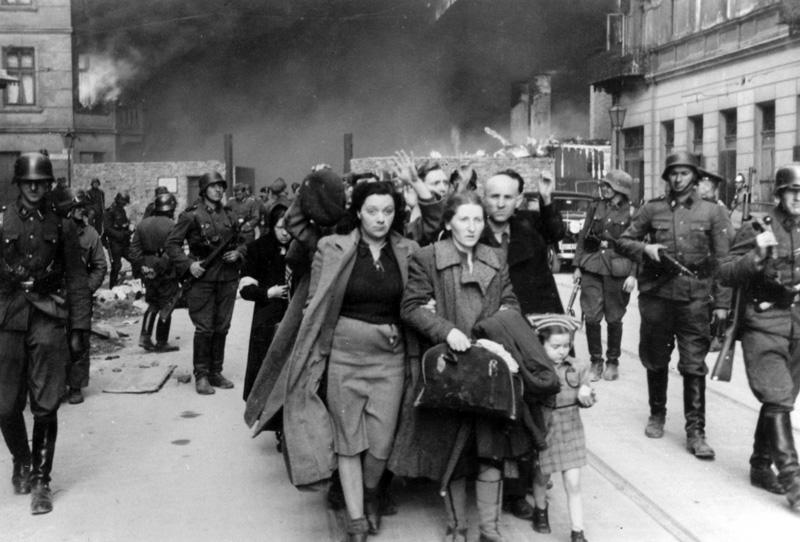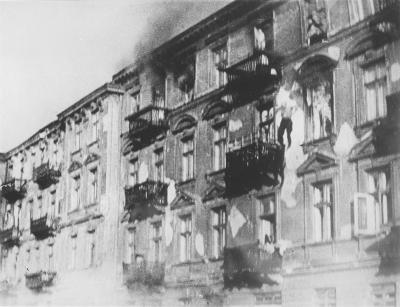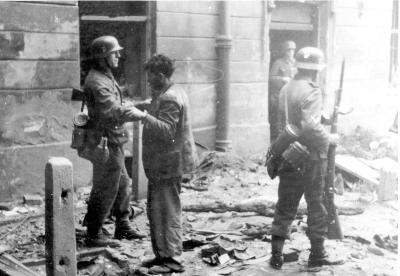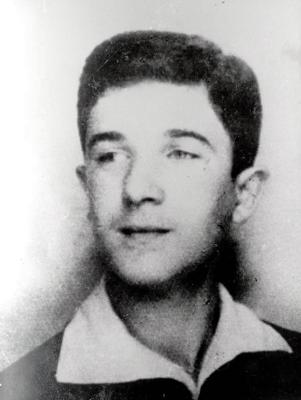The words of Mordechai Anielewicz, commander of the Jewish Fighting Organization (Żydowska Organizacja Bojowa, ŻOB), in a letter he wrote as the battle raged, sum up the unique power of this revolt. The Warsaw Ghetto Uprising, which broke out on the eve of Passover, 19 April 1943, was the first urban rebellion against Nazi Germany in all the territories it occupied. Of all the Jewish uprisings during the Holocaust, this was the longest-running, and had the largest number of participants. It was a popular insurrection: While the combatants of ŻOB and ŻZW (Żydowski Związek Wojskowy, the Jewish Military Union) were fighting in the streets of the ghetto, the Jews barricaded themselves in bunkers. After a few days of fighting, the Germans began to systematically torch and blow up the ghetto houses in order to overcome the fighters and force the fugitives out of their hiding places. For a month, the Jews of the Warsaw ghetto fought for their lives. Many died in traps of fire and smoke. News of the revolt spread quickly and even reached the free world, and it became a symbol of the battle of the few against the many, and of the freedom and power of the human spirit.
Characteristics of Jewish Resistance
The Warsaw Ghetto Uprising was one of many acts of armed and unarmed Jewish resistance, in response to the persecution, oppression and humiliation the Jews were suffering at the hands of Nazi Germany and its allies. Jewish resistance took many forms: spiritual, cultural, clandestine-political, educational or religious resistance; underground documentation of the events; forging identity cards and protection papers; hiding Jews; smuggling thousands of Jews across borders to safer places; escape from camps and ghettos; armed uprisings and joining national resistance movements; aiding the Allies; and more. Many of these actions were an expression of defiance by the Jews against the extreme persecution of the Germans and their accomplices, and were executed in an attempt to preserve both body and soul.
The Jews in the German-occupied territories were a small, multigenerational and divided minority of civilians living among largely indifferent and often even hostile populations. Facing them was the most powerful state in Europe, which turned all its force against them. Under these conditions, they were presented with agonizing and desperate dilemmas, and those who planned to fight and defend themselves did so knowing that they could not save the majority. At a discussion that took place in Vilna in December 1941, Abba Kovner said:
"Is there any chance of rescue? We must give the true answer, cruel though it may be. No. There is no rescue. Our answer must be clearer still – perhaps there is a possibility that tens or hundreds of Jews will be saved: But for our people as a whole, the millions of Jews in the area of German occupation, there is no chance."
Any decision or action of an individual Jew or an underground group endangered the lives of many. Some realized that because Germany's overarching goal was to murder all Jews, resistance would not be able to change the fate of the masses: "Our activity may bring the end closer – but that end will come in any case," said Kovner.
Revolts, Escapes, Border Running and Concealment
Jews in dozens of communities tried to organize uprisings: In Vilnius, Bialystok, Krakow and elsewhere, desperate attempts were made to commit an act of insurgence that was usually not intended for rescue, but rather as a symbolic gesture for the dignity of the people. In the camps, too, Jewish prisoners organized armed uprisings. This was the case in Treblinka and Sobibor, as well as the Sonderkommando uprising in Auschwitz-Birkenau, in which a group of prisoners – most of them from Greece, Poland and Hungary – blew up one of the crematoria buildings in October 1944. Sometimes, the fighting lasted only a number of hours or a few days. There were cases, such as in the Łachwa ghetto, where the purpose of the revolt was to enable a mass escape to the surrounding forests.
Hundreds of thousands of Jews fled alone or in groups from dozens of localities, deportation trains, camps, and even extermination camps in an attempt to save their lives and those of others. The timing, topography and attitude of the local population to the Jews were among the factors that influenced the outcome of these escape attempts. Only a handful of the escapees from the summer of 1941 until the end of the war survived. Thus, for example, only 20 of the 2,000 fugitives from the Tuczyn ghetto lived to see liberation.
One form of resistance was the rescue of Jews by Jews who were themselves suffering from persecution. Thus, for example, members of the "Working Group" in Slovakia and the Zionist underground in Hungary organized the smuggling of thousands of Jews across the border. In Romania, in violation of government directives, the Union of Jewish Communities endeavored to assist as many deportees to Transnistria in order for them to endure in unspeakable living conditions for as long as possible.
Rescue of children was at the forefront of the minds of Jewish resistance activists. To this end, Jewish underground networks cooperated with their non-Jewish counterparts, and even with official Jewish organizations that also carried out illegal activities for the sake of saving the children. In this way, thousands of Jewish children were rescued in Belgium, the Netherlands, France and Hungary.
Opposition of Jews Within the War Efforts Against Germany and Its Collaborators
Jewish underground activists contributed to the war against Nazi Germany, and to its and its collaborators' defeat. The thousands of Jewish partisans who fought in the forests of Eastern Europe were an important factor in battling the Germans and rescuing thousands of Jews who had fled to the forests. The Jewish partisans established Jewish units or joined general partisan groups, and fought in the partisan ranks not only in Eastern Europe, but also in many other European countries, such as Yugoslavia, Greece and Bulgaria. In Algeria, members of the Jewish underground helped the Allied forces land and occupy the country.
Defiance: Preservation of Identity and Society
Jewish defiance during the Holocaust was also reflected in spiritual and cultural resistance. Jews risked their lives and continued openly and demonstratively, or secretly and underground, to keep mitzvot (Jewish commandments), to preserve their spirituality and faith, to operate educational networks, to maintain support systems and to preserve Jewish culture. Elie Wiesel wrote:
"The Jewish soul was a target of the enemy. He sought to corrupt it, even as he strove to destroy us physically. But despite his destructive force, despite his corrupting power, the Jewish soul remained beyond his reach."
While persecuted to the hilt, many Jews violated the orders of the Germans and their associates, disobeying their commands and maintaining as far as possible a rooted way of life as an expression of non-submission, preserving their identity and dignity.
Prominent in this context is the safeguarding of their religious traditions and the Jewish circle of life. Many celebrated holidays secretly, some held prayer quorums, and a number tried to keep kashrut and purity laws. Another significant, existential effort was manifested in ghettos, where plays and concerts were staged, underground libraries operated, poems and underground newspapers were printed and circulated, and a bustling cultural life was secretly practiced. In the hope, albeit desperate, that they would see the end of the war and unite with relatives and community members, the resisters sought to maintain vitality and at the same time give expression to the grim reality of subsistence and persecution. Educational activities took place in flagrant opposition to the Germans, in the full knowledge of the mortal risk being taken, out of a sense of mission and responsibility for the children's souls. Teacher and educator Chaim Aharon Kaplan expressed this particularly well in his diary, written in Warsaw in August 1940:
"In these days of our misfortune, we live the life of Marranos. Everything is forbidden to us, and yet we do everything."
Wherever the Germans and their allies ruled, the persecuted Jews worked alone, within groups and as a part of communities for their physical survival, but also for the preservation of the cultural, religious and educational life of the Jewish people.
Ultimately, the widespread resistance did not have the capability of saving masses of Jews. In view of the determination of the Nazis to implement the "Final Solution" and the force they and their accomplices wielded, resistance and fighting was a struggle of the tormented, abandoned to their fate. And yet, the scope and versatility of Jewish resistance during the Holocaust in all of its forms has bequeathed a Jewish legacy for generations, symbolizing the power of the human spirit and humanity's fundamental values.











